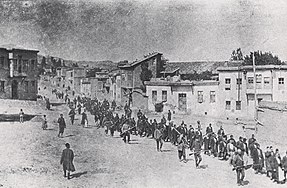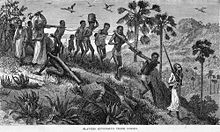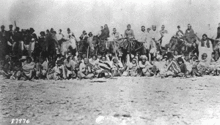Death march

A death march is a forced
Death marches usually feature harsh physical labor and abuse, neglect of prisoner injury and illness,
Notable death marches
Jingkang incident
In 1127, during the Jin–Song Wars, the forces of the Jurchen-led Jin dynasty besieged and sacked the Imperial palaces in Bianjing (present-day Kaifeng), the capital of the Han-led Song dynasty. The Jin forces captured the Song ruler, Emperor Qinzong, along with his father, the retired Emperor Huizong, as well as many members of the imperial family and officials of the Song imperial court. According to The Accounts of Jingkang, Jin troops looted the imperial library and palace. Jin troops also abducted all the female servants and imperial musicians. The imperial family was abducted and their residences were looted. Facing the prospect of captivity and enslavement by the Jurchens, numerous palace women chose to take their own lives. The remaining captives, over 14,000 people, were forced to march alongside the seized assets towards the Jin capital. Their entourage – almost all the ministers and generals of the Northern Song dynasty – suffered from illness, dehydration, and exhaustion, and many never made it. Upon arrival, each person had to go through a ritual where the person had to be naked and wearing only sheep skins.[2]
African slave trade
Forced marches were utilized against slaves who were bought or captured by slave traders in Africa. They were shipped to other lands as part of the East African slave trade with Zanzibar and the Atlantic slave trade. Sometimes, the merchants shackled the slaves and provided insufficient food. Slaves who became too weak to walk were frequently killed or left to die.[3][4]

David Livingstone wrote of the East African slave trade:
We passed a slave woman shot or stabbed through the body and lying on the path. [Onlookers] said an Arab who passed early that morning had done it in anger at losing the price he had given for her, because she was unable to walk any longer.[5]
Forced displacement of Native Americans

As part of Native American removal in the United States, approximately 6,000
Congo Free State
King Leopold II sanctioned the creation of "child colonies" in his Congo Free State which had orphaned Congolese kidnapped and sent to schools operated by Catholic missionaries in which they would learn to work or be soldiers; these were the only schools funded by the state. More than 50% of the children sent to the schools died of disease, and thousands more died in the forced marches into the colonies. In one such march, 108 boys were sent over to a mission school and only 62 survived, eight of whom died a week later.[13]
Dungan Revolt (1862–1877)
During the Dungan Revolt (1862–1877), 700,000 to 800,000 Hui Muslims from Shaanxi were deported to Gansu, in a process in which most were killed along the way from thirst, starvation, and massacres by the militia escorting them, with only a few thousand surviving.[14]
Armenian Genocide
The
World War I
Grand Duke Nicolas (who was still commander-in-chief of the Western forces), after suffering serious defeats at the hands of the German army, decided to implement the decrees for the German Russians living under his army's control, principally in the Volhynia province. The lands were to be expropriated, and the owners deported to Siberia. The land was to be given to Russian war veterans once the war was over. In July 1915, without prior warning, 150,000 German settlers from Volhynia were arrested and shipped to internal exile in Siberia and Central Asia. (Some sources indicate that the number of deportees reached 200,000). Ukrainian peasants took over their lands. While precise figures remain elusive, estimates suggest that the mortality rate associated with these deportations ranged from 30% to 50%, translating to a death toll between 63,000 and 100,000 individuals.[citation needed]
In the eastern part of Russian Turkestan, after the suppression of the
World War II


During World War II, death marches of POWs occurred in both German-occupied Europe and the Japanese colonial empire. Death marches of those held in Nazi concentration camps were common in the later stages of the Holocaust as Allied forces closed in on the camps. One infamous death march occurred in January 1945, as the Soviet Red Army advanced on German-occupied Poland. Nine days before the Red Army arrived at the Auschwitz concentration camp, the Schutzstaffel marched nearly 60,000 prisoners out of the camp towards Wodzisław Śląski, where they were put on freight trains to other camps. Approximately 15,000 prisoners died on the way.[18][19] The death marches were judged during the Nuremberg trials to be a crime against humanity.[citation needed] On the Eastern Front, death marches were amongst the forms of German atrocities committed against Soviet prisoners of war.
During the NKVD prisoner massacres in 1941, NKVD personnel led prisoners on death marches to various locations in Eastern Europe; upon arriving to pre-designated execution sites, the survivors were summarily executed. After the Battle of Stalingrad in February 1943, numerous German prisoners of war in the Soviet Union were subject to death marches; after enduring a period of captivity near Stalingrad, they were sent by the Soviet authorities on a "death march across the frozen steppe" to labor camps elsewhere in the Soviet Union.[20][21]
The
In the Pacific theatre, the Imperial Japanese Armed Forces conducted death marches of Allied POWs, including the 1942 Bataan Death March and the 1945 Sandakan Death Marches. The former forcibly transferred 60–80,000 POWs to Balanga, resulting in the deaths of 2,500–10,000 Filipino and 100–650 American POWs, while the latter caused the deaths of 2,345 Australian and British POWs, of which only 6 survived. Lieutenant-General Masaharu Homma was charged with failure to control his troops in 1945 in connection with the Bataan Death March.[24][25] Both the Bataan and Sandakan death marches were judged by the International Military Tribunal for the Far East to be war crimes.[citation needed]
Population transfer in the Soviet Union
1948 Palestinian expulsion from Lod and Ramla
Korean War
During the
Phnom Penh
The Khmer Rouge marked the beginning of their rule with the forced evacuation of various cities including Phnom Penh, Cambodia.
See also
- Carolean Death March (1718–1719)
- Samsun deportations (1921–1922)
- March of the Living
- Armenian genocide
- Assyrian genocide
- Flight and expulsion of Germans (1944–1950)
- Forced displacement
- Population exchange between Greece and Turkey
- List of ethnic cleansing campaigns
References
- ^ "Definition of DEATH MARCH". www.merriam-webster.com.
- ^ "The Accounts of Jingkang" (靖康稗史箋證) 「临行前俘虏的总数为14000名,分七批押至北方,其中第一批宗室贵戚男丁二千二百余人,妇女三千四百余人」,靖康二年三月二十七日,「自青城国相寨起程,四月二十七日抵燕山,存妇女一千九百余人。」("There were 14,000 captives divided into seven groups when the march commenced. The first group, composed of imperial family members and nobles, contained 2,200 males and 3,400 females and departed on the 27th day of the third month from the Qingcheng stockade. When it arrived in Yanshan on the 27th day of the following month, just over 1,900 females remained.")
- OCLC 230753290.
- ISBN 978-1412826938.
- ISBN 184637555X.
- ^ "Trail of Tears". Choctaw Nation. Archived from the original on 2016-03-12.
- ^ Foreman, Grant (1974) [1932]. Indian Removal: The Emigration of the Five Civilized Tribes of Indians. University of Oklahoma Press. Archived from the original on April 13, 2012.
- ^ "Creeks". Everyculture.com.
- ISBN 978-0813917986.
- ^ Dizard, Jesse A. (2016). "Nome Cult Trail". ARC-GIS storymap. technical assistance from Dexter Nelson and Cathie Benjamin. Department of Anthropology, California State University, Chico – via Geography and Planning Department at CSU Chico.
- ^ Immanuel, Marc (21 April 2017). "The Forced Relocation of the Yavapai".
- ISBN 978-1622336524.
- ^ Hochschild, Adam. King Leopold's Ghost A Story of Greed, Terror, and Heroism in Colonial Africa. Mariner Books. p. 135.
- ^ "回族 – 广西民族报网". Archived from the original on 2021-01-22. Retrieved 2022-12-22.
- ^ "Exiled Armenians Starve in the Desert". The New York Times. Boston. August 8, 1916.
- ISBN 978-0521829588.
- ^ Bruce Pannier (2 August 2006). "Kyrgyzstan: Victims Of 1916 'Urkun' Tragedy Commemorated". RFE/RL.
- ^ "Death marches". United States Holocaust Memorial Museum. Archived from the original on 2009-08-25.
- ISBN 0688123643. (map of forced marches)
- ISBN 978-0141032405.
- ISBN 978-0757001604.
- ^ Corsellis, John, & Marcus Ferrar. 2005. Slovenia 1945: Memories of Death and Survival After World War II. London: I.B. Tauris, p. 204.
- ISSN 0352-342X. Retrieved 24 March 2015.
- ^ Steiner, K., Lael, R. R., & Taylor, L. (1985). War Crimes and Command Responsibility: From the Bataan Death March to the MyLai Massacre. Pacific Affairs, 58(2), 293.
- ^ Maguire, Peter. Law and War: International Law and American History. Columbia University Press (2010), 108
- ISBN 0786403365.
- ISBN 0786403365. Pohl cites Russian archival sources for the death toll in the special settlements from 1941-49
- ^ "UNPO: Chechnya: European Parliament recognises the genocide of the Chechen People in 1944". unpo.org.
- OCLC 587249108.
- ISBN 978-0415777575.
- ^ "Ukraine's Parliament Recognizes 1944 'Genocide' Of Crimean Tatars". RadioFreeEurope/RadioLiberty. 12 November 2015.
- ISBN 978-0521009676.
- ^ "Israel Bars Rabin from Relating '48 Eviction of Arabs". The New York Times. 23 October 1979.
- ISBN 978-0198662099.
On 12 July, the Arab inhabitants of the Lydda-Ramle area, amounting to some 70,000, were expelled in what became known as the 'Lydda Death March'.
- ISBN 978-0786410910.
- ISBN 0312286848.
Further reading
- Bibliography of Genocide studies
